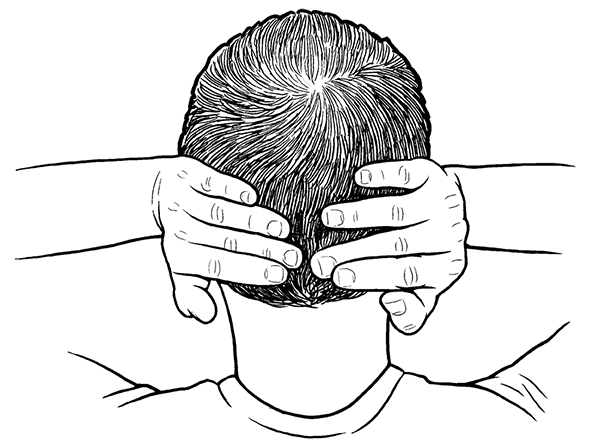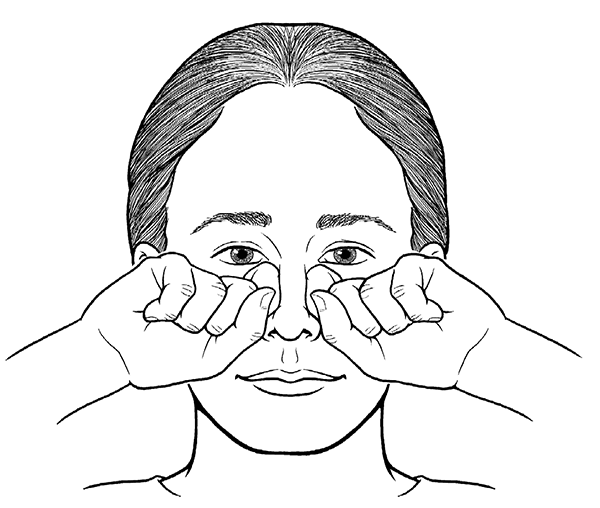Chinese Healing Exercises (25 page)
Read Chinese Healing Exercises Online
Authors: Steven Cardoza
Tags: #Taiji, #Qi Gong, #Daoist yoga, #Chinese Healing, #Health, #medicine, #remedy, #energy

 Figure 8.5A (Beating the Heavenly Drum)
Figure 8.5A (Beating the Heavenly Drum)
 Figure 8.5B (Beating the Heavenly Drum)
Figure 8.5B (Beating the Heavenly Drum)
 Figure 8.5C (Beating the Heavenly Drum)
Figure 8.5C (Beating the Heavenly Drum)
In the second variation of the Heavenly Drum, getting that drum beat sound can be a little trickier, but once you have some experience with the first variation, you know what to look for. Here, place the palms of each hand over each ear, with your fingertips curling rearward to the back of your head. Your middle fingers should lie just at the lower ridge of your occiput, the base of your skull
(
Fig 8.5A
),
so that your index fingers will touch the skin and muscle just below, at the very top of your neck. Keeping your palms over your ears and your little, ring, and middle fingers firmly in contact with your skull (thumbs can touch your neck or hang down freely), place your index fingers directly on top of your middle fingers
(
Fig 8.5B
),
and then flick them with just a little force so that they tap your upper neck
(
Fig 8.5C
).
You should hear the same drum beat when doing this as you heard in the first variation, although possibly less sharp or at a slightly lower pitch. The Urinary Bladder (UB) meridian runs exactly under the spot the tips of your index finger will tap when doing this variation, so you will get an extra benefit from that. The UB is the Yang organ paired with the Yin Kidneys. The UB meridian runs down your back in parallel lines flanking your spine and directly overlays the Kidneys, so stimulating qi flow there helps release obstruction along your back, useful as an adjunct to reduce back pain, and offers more direct stimulation of the kidneys. As with the first variation, tap thirty-six times.
7. Ear Pop
In addition to its Kidney correspondence, the ear has direct connections with three Yang meridians: the Small Intestine, the Gall Bladder, and the Sanjiao. This simple exercise stimulates those meridians (whose local points are used to treat various ear problems) while simultaneously freeing up the small physical structures just within and surrounding the ear. The slight vacuum this creates can also help dislodge waxy buildup within the ear. Even in the absence of any known hearing problems, those factors combine to sharpen the sense of hearing, and generally make your ears feel good.
Insert your little fingers into each ear, deeply enough so that your ears feel blocked and your hearing is reduced, but not so deep that you feel uncomfortable pressure on your eardrums. Then make circles with your little fingers, directing the force of the circles toward the wall of the ear canal and not toward your eardrums. You should feel the ear canal move. If there are any adhesions surrounding your ear canal, you may hear a slight crackling as they are freed. This should not cause any pain. Make twelve circles forward, and then twelve circles backward. Then curl your little fingers slightly, so they make ever more firm contact with the ear canals, and quickly pull them out of your ears, producing a soft popping sound. If you've dislodged any ear wax, the suction will help pull it from your ears.
Nose Exercises
8. Friction Massage to Sides of the Nose
The nose is the sense organ associated with the Lungs. This simple exercise helps with breathing problems, clears the sinuses, improves the sense of smell, and brings more qi and blood to the nose in preparation for the next exercise. Especially when combined with the next exercise, this also benefits the throat, which is the passageway between nose and lungs, and reduces the occurrence and severity of colds and flus.
 Figure 8.6 (Friction Massage to Sides of the Nose)
Figure 8.6 (Friction Massage to Sides of the Nose)
Step 1
: Different Chinese teachers have slightly different preferred hand and finger positions for this. The results are very similar, but each position produces its own variation and places a slightly different emphasis on different parts of the nose, stimulating those areas to a greater or lesser degree. Experiment with both of these and see which you like best. Choose either one to start with, and feel free to alternate them at will.
Hand Position 1:
For the first hand position, make a loose fist, and open your index finger just enough so that you can place the pad of your thumb on the fingernail of your index finger. Flanking your nose, place the backs of your index fingers on your cheeks, so that the knuckle of your index fingers are near or at the bridge of your nose, and the sides of your index fingers are touching the sides of your nose (
Fig 8.6
).
Hand Position 2:
For the second hand position, keep your hands fully opened with your thumbs out at, or near, right angles to your hand. Placing your thumbs under your jaw, lay your index fingers at the sides of your nose so that the palm surface of the index fingers contact your nose, while the near sides of your index fingers, the side of the index fingers closest to your thumbs, touch your cheek at the sides of your nose (
Fig 8.7
). In this illustration, the middle, ring, and little fingers are folded to better show the index finger position.
Step 2
: Using either hand position, rub your index fingers up and down briskly along the sides of your nose, for ten to thirty seconds. Hand position 1 will create a little more external friction and warmth on the surface of your skin, and naturally stimulate the points closer to the bridge of your nose. You can stimulate the points closer to the tip of your nose if you make sure to move your knuckles down that low. Hand position 2 doesn't create much external friction, since your index fingers remain in firmer contact with your skin, with less sliding on the surface. This position will naturally free up the mucus membranes inside your nose a little better. Both bring qi and blood to your nose equally well, and both stimulate the points flanking your nose.
 Figure 8.7 (Friction Massage to Sides of the Nose)
Figure 8.7 (Friction Massage to Sides of the Nose)
 Figure 8.8Aâ8.8D (Seven Point Nasal Acupressure Massage)
Figure 8.8Aâ8.8D (Seven Point Nasal Acupressure Massage)
9. Seven Point Nasal Acupressure Massage
This exercise picks up where the previous one left off. Now that you have more qi and blood at your nose, stimulating the local acupuncture points with direct finger pressure will have an even greater effect.
Locate the acupoints in this way. The first pair of points are just to the sides of your nostrils. If you place both index fingers at the very tip of your nose and slide them outwards along your nostrils until they reach where your nose joins your face (cheeks), your fingertips will come to rest on the first points (
Fig 8.8A
). If you press straight in, you'll feel a slight depression in the bone there. Because your fingertips are much wider than an acupuncture needle, you'll be covering two acupoints at the same time, Large Intestine 20 (the Chinese name translates as “Welcome Fragrance”) and just slightly below, Large Intestine 19. Both points are used traditionally to clear the lungs, decongest the nose, open the channel locally, and helps to dispel the invasion of pathogenic factors that can cause a coldâin this case, primarily Wind.
The second pair of points flank the nose slightly higher up, near where the cartilage ends and the nasal bone begins. Pressing toward the bones of your face (as opposed to toward your nose), you will feel another bony depression
(
Fig 8.8B
on previous page
).
This corresponds to the extra acupoint called Bitong, sometimes referred to as Upper Large Intestine 20, and translates as “Penetrating the Nose” or “Nose Passage.” In addition to traditionally clearing heat and dispelling wind in order to treat nasal diseases and improve overall nose function, it also benefits the eyes and sharpens eyesight.
The third pair of points are located at the bridge of the nose, at the height of the inner corner of the eyes. Direct your finger pressure toward the bridge of your nose to feel the bony indentation there
(
Fig 8.8C
on previous page
).
This is close to, but not exactly on, Urinary Bladder 1, another point used to clear heat and sharpen eyesight. Because your finger pressure is directed toward your nose, these points benefit nasal function as well.